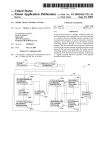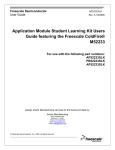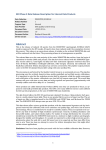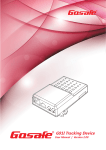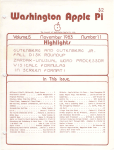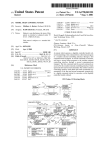Download Model train control system
Transcript
US006494408B2 (12) United States Patent (10) Patent N0.: Katzer US 6,494,408 B2 (45) Date of Patent: *Dec. 17, 2002 (54) MODEL TRAIN CONTROL SYSTEM 4,853,883 A 5,072,900 A 8/1989 Nickles et al. 12/1991 Malon (75) Inventor: 5,475,818 A 5,493,642 A 12/1995 M°1Ynea_11X ct a1~ 2/1996 Dunsmulr et 91 - Matthew A. Katzer, 1416 NW. Ben?eld Dr., Portland, OR (US) 97229 _ - (73) Assignee. Mjzgtthew A. Katzer, Hillsboro, OR ( . ( * ) Notice: . . . SubJect to any disclaimer, the term of this Th' 1 t ' b' 21 t t t ' 0 a ermma 5,828,979 A 10/1998 Polivka et al. Okumura et al. 7/1998 Balukin et a1‘ 5 896 017 A 4 1999 5:952:797 A 6,065,406 A 9/1999 Rossler 5/2000 KatZer 6,270,040 8/2001 5’940’005 A patent is extended or adjusted under 35 U.S.C. 154(1)) by 0 days. daring? en 1s su Jec 10/1997 Kull 12/1997 5,787,371 A ) . 5,681,015 A 5,696,689 A l d' - 1s 1 * S t l. 82999 5:32:22 ; 2L KatZer ...................... .. 246/1 R OTHER PUBLICATIONS Chapell, David. Understanding ActiveX and OLE. Red d : M'1croso ft P ress, 1996 . Appl . N 0.: 09/858 , 297 mon (22) Filed: May 15, 2001 * cited by examiner (65) Prior Publication Data Primary Examiner—Mark T. be (74) Attorney, A gent, or Firm—Chernoff Vilhauer McClung US 2002/0113171 A1 Aug. 22, 2002 & Stenzel, LLP Related US. Application Data (63) (51) Continuation of application No. 09/541,926, ?led on Apr. 3, ABSTRACT A system Which operates a digitally controlled model rail 2000: HOW Pat- N°~ 672707049 road transmitting a ?rst command from a ?rst client program Int. c1.7 ................................................ .. G05D 1/00 to a resident eXternal Controlling interface thrqugh a ?rst (52) us CL (58) (57) 246/1 R; 701/19 Field of Search communications transport. A second command is transmit 246/1 R 3 5 ted from a second client program to the resident external 24646 2 500’ 5’40’ 825 825 01 82’5 03 825 06 825' 67 8&5 22’ ’ ' 82’5 52' 28’6 01 ' 28’6 02' 761/19' 20’ controlling interface through a second communications transport. The ?rst command and the second command are received by the resident external controlling interface Which ' (56) ’ ' ’ ' ’ ’ queues the ?rst and second commands. The resident external References Cited controlling interface sends third and fourth commands rep resentative of the ?rst and second commands, respectively, U.S. PATENT DOCUMENTS to a digital command station for execution on the digitally controlled model railroad. 3,944,986 A 3,976,272 A 4,307,302 A 3/1976 Staples 8/1976 Murray et al. 12/1981 Russell 43 Claims, 13 Drawing Sheets . if, mREsPoNsE a T m E STORAGE \7108 ‘ EXTERNAL‘ ccmRnL < , “2 “I U.S. Patent Dec. 17, 2002 Sheet 8 0f 13 US 6,494,408 B2 .95mm“ MZ.NOHD<EUOI~QHmZ ZM“O0HE<U3SOMIQ%HZ m T2ZmO|3EI5UW04HNlM ZmQEIUO0NME TE|DlHZI ZmWOEIU0OHMNE ETIS|Q'/l2 WmUvTZz1AhFH|Eé.Qm M T m w U z I / g a l é m U E Z T m W | O D F U I H 0 O 1 N ; M Q 2 I 0 ~ 9 n 6 5 : c 2 / 8 E m ZT"IMQSHUAWiONIME WUZITH|AVMQ1<IL U.S. Patent Dec. 17, 2002 Sheet 13 0f 13 US 6,494,408 B2 COMMAND QUEUE PRIORITY TYPE COMMAND 5 37 A ' INCREASE LOCO 1 BY 2 B OPEN SWITCH 1 15 B CLOSE SWITCH l 26 B OPEN SWITCH 1 6 A DECREASE LOCO 2 BY 5 176 B CLOSE SWITCH 6 123 35 5 9 0 37 C D A A E D TURN ON LIGHT 5 QUERY LOCO 3 INCREASE LOCO 2 BY 7 DECREASE LOCO 1 BY 2 MISC QUERY LOCO 2 215 g D QUERY SWITCH 1 216 l‘ C TURN ON LIGHT 3 227 D , QUERY SWITCH 5 225 0 C D , TURN ON LOCO 1 LIGHT QUERY ALL 255 A STOP LOCO 1 FIG. 11 US 6,494,408 B2 1 2 MODEL TRAIN CONTROL SYSTEM netWork such as the internet. One technique to decrease the response time is to use high-speed netWork connections but unfortunately such connections are expensive. What is desired, therefore, is a system for controlling a model railroad that effectively provides a high-speed con This is a continuation of US. application Ser. No. 09/541,926, ?led Apr. 3, 2000, now US. Pat. No. 6,270,040, for MODEL TRAIN CONTROL SYSTEM. nection Without the additional expense associated thereWith. BACKGROUND OF THE INVENTION The foregoing and other objectives, features, and advan tages of the invention Will be more readily understood upon The present invention relates to a system for controlling a model railroad. 10 Model railroads have traditionally been constructed With draWings. of a set of interconnected sections of train track, electric sWitches betWeen different sections of the train track, and SUMMARY OF THE PRESENT INVENTION other electrically operated devices, such as train engines and draW bridges. Train engines receive their poWer to travel on the train track by electricity provided by a controller through the track itself. The speed and direction of the train engine is controlled by the level and polarity, respectively, of the electrical poWer supplied to the train track. The operator manually pushes buttons or pulls levers to cause the 15 20 sWitches or other electrically operated devices to function, as desired. Such model railroad sets are suitable for a single operator, but unfortunately they lack the capability of adequately controlling multiple trains independently. In addition, such model railroad sets are not suitable for being controlled by multiple operators, especially if the operators 25 are located at different locations distant from the model railroad, such as different cities. Adigital command control (DDC) system has been devel oped to provide additional controllability of individual train 30 tor desires to control, such as a train engine, includes an individually addressable digital decoder. Adigital command station (DCS) is electrically connected to the train track to 35 digital command station is typically controlled by a personal computer. A suitable standard for the digital command control system is the NMRA DCC Standards, issued March 1997, and is incorporated herein by reference. While pro viding the ability to individually control different devices of the railroad set, the DCC system still fails to provide the capability for multiple operators to control the railroad devices, especially if the operators are remotely located from The present invention overcomes the aforementioned draWbacks of the prior art, in a ?rst aspect, by providing a system for operating a digitally controlled model railroad that includes transmitting a ?rst command from a ?rst client program to a resident external controlling interface through a ?rst communications transport. A second command is transmitted from a second client program to the resident external controlling interface through a second communica tions transport. The ?rst command and the second command are received by the resident external controlling interface Which queues the ?rst and second commands. The resident external controlling interface sends third and fourth com mands representative of the ?rst and second commands, respectively, to a digital command station for execution on engines and other electrical devices. Each device the opera provide a command in the form of a set of encoded digital bits to a particular device that includes a digital decoder. The consideration of the folloWing detailed description of the invention, taken in conjunction With the accompanying 40 the digitally controlled model railroad. Incorporating a communications transport betWeen the multiple client program and the resident external controlling interface permits multiple operators of the model railroad at locations distant from the physical model railroad and each other. In the environment of a model railroad club Where the members Want to simultaneously control devices of the same model railroad layout, Which preferably includes multiple trains operating thereon, the operators each provide com mands to the resistant external controlling interface, and hence the model railroad. In addition by queuing by com mands at a single resident external controlling interface permits controlled execution of the commands by the digi tally controlled model railroad, Would may otherWise con ?ict With one another. 45 In another aspect of the present invention the ?rst com mand is selectively processed and sent to one of a plurality of digital command stations for execution on the digitally controlled model railroad based upon information contained a remote location. The softWare includes an interface Which therein. Preferably, the second command is also selectively alloWs the operator to select desired changes to devices of the railroad set that include a digital decoder, such as increasing the speed of a train or sWitching a sWitch. The softWare issues a command locally or through a netWork, 50 processed and sent to one of the plurality of digital command stations for execution on the digitally controlled model railroad based upon information contained therein. The the railroad set and each other. DigiToys Systems of LaWrenceville, Ga. has developed a softWare program for controlling a model railroad set from resident external controlling interface also preferably includes a command queue to maintain the order of the such as the internet, to a digital command station at the railroad set Which executes the command. The protocol used by the softWare is based on Cobra from Open Management commands. 55 Group Where the softWare issues a command to a commu nication interface and aWaits con?rmation that the command Was executed by the digital command station. When the softWare receives con?rmation that the command executed, the softWare program sends the next command through the communication interface to the digital command station. In other Words, the technique used by the softWare to control the model railroad is analogous to an inexpensive printer Where commands are sequentially issued to the printer after the previous command has been executed. Unfortunately, it has been observed that the response of the model railroad to the operator appears sloW, especially over a distributed 60 The command queue also alloWs the sharing of multiple devices, multiple clients to communicate With the same device (locally or remote) in a controlled manner, and multiple clients to communicate With different devices. In other Words, the command queue permits the proper execu tion in the cases of: (1) one client to many devices, (2) many clients to one device, and (3) many clients to many devices. In yet another aspect of the present invention the ?rst command is transmitted from a ?rst client program to a ?rst 65 processor through a ?rst communications transport. The ?rst command is received at the ?rst processor. The ?rst proces sor provides an acknowledgement to the ?rst client program through the ?rst communications transport indicating that US 6,494,408 B2 3 4 the ?rst command has properly executed prior to execution of commands related to the ?rst command by the digitally controlled model railroad. The communications transport is client program 14 and a resident external controlling inter face 16. The client program 14 executes on the model preferably a COM or DCOM interface. The model railroad application involves the use of extremely slow real-time interfaces between the digital command stations and the devices of the model railroad. In order to increase the apparent speed of execution to the client, other than using high-speed communication interfaces, the resident external controller interface receives the command and provides an acknowledgement to the 10 tor accesses using the graphical interface or other programs client program in a timely manner before the execution of the command by the digital command stations. Accordingly, the execution of commands provided by the resident exter nal controlling interface to the digital command stations 15 trol commands to the model railroad. The communications transport 12 provides an interface between the client program 14 and the resident external manner. The COM and DCOM communications transport between the client program and the resident external con trolling interface is operated in an asynchronous manner, controlling interface 16. The communications transport 12 namely providing an acknowledgement thereby releasing may be any suitable communications medium for the trans mission of data, such as the internet, local area network, satellite links, or multiple processes operating on a single the communications transport to accept further communica tions prior to the actual execution of the command. The computer. The preferred interface to the communications 25 interface to verify that the command is proper and cause the commands to execute in a controlled manner by the digital command stations, all without additional high-speed com system resident or remotely located on an external system. The communications transport 12 may also use private or public communications protocol as a medium for commu munication networks. Moreover, for traditional distributed software execution there is no motivation to provide an nications. The client program 14 provides commands and the resident external controlling interface 16 responds to the communications transport 12 to exchange information. A 35 prior command so there would be no motivation to provide an acknowledgment prior to its actual execution. Microsoft Press, and is incorporated by reference herein. Incorporating a communications transport 12 between the client program(s) 14 and the resident external controlling interface 16 permits multiple operators of the model railroad FIG. 1 is a block diagram of an exemplary embodiment of a model train control system. FIG. 2 is a more detailed block diagram of the model train at locations distant from the physical model railroad and each other. In the environment of a model railroad club where the members want to simultaneously control devices control system of FIG. 1 including external device control 45 of the same model railroad layout, which preferably includes multiple trains operating thereon, the operators each provide FIG. 3 is a block diagram of the external device control commands to the resistant external controlling interface, and hence the model railroad. logic of FIG. 2. FIG. 4 is an illustration of a track and signaling arrange The manner in which commands are executed for the model railroad under COM and DCOM may be as follows. ment. FIG. 5 is an illustration of a manual block signaling The client program 14 makes requests in a synchronous manner using COM/DCOM to the resident external interface controller 16. The synchronous manner of the request is the technique used by COM and DCOM to execute commands. arrangement. FIG. 6 is an illustration of a track circuit. FIGS. 7A and 7B are illustrations of block signaling and track capacity. description of COM (common object model) and DCOM (distributed common object model) is provided by Chappel in a book entitled Understanding ActiveX and OLE, BRIEF DESCRIPTION OF THE SEVERAL VIEWS OF THE DRAWINGS logic. transport 12 is a COM or DCOM interface, as developed for the Windows operating system available from Microsoft Corporation. The communications transport 12 also deter mines if the resident external controlling interface 16 is taneously while permitting the resident external controlling acknowledgment prior to the execution of the command because the command executes quickly and most commands are sequential in nature. In other words, the execution of the next command is dependent upon proper execution of the such as Visual Basic, C++, Java, or browser based applica tions. There may be multiple client programs interconnected with the resident external controlling interface 16 so that multiple remote operators may simultaneously provide con occur in a synchronous manner, such as a ?rst-in-?rst-out combination of the synchronous and the asynchronous data communication for the commands provides the bene?t that the operator considers the commands to occur nearly instan railroad operator’s computer and may include any suitable system to permit the operator to provide desired commands to the resident external controlling interface 16. For example, the client program 14 may include a graphical interface representative of the model railroad layout where the operator issues commands to the model railroad by making changes to the graphical interface. The client pro gram 14 also de?nes a set of Application Programming Interfaces (API’s), described in detail later, which the opera 55 The communications transport 12 packages the command FIG. 8 is an illustration of different types of signals. FIGS. 9A and 9B are illustrations of speed signaling in approach to a junction. FIG. 10 is a further embodiment of the system including a dispatcher. face 16 then passes the command to the digital command stations 18 which in turn executes the command. After the digital command station 18 executes the command an FIG. 11 is an exemplary embodiment of a command queue. controlling interface 16 which in turn passes an acknowl DETAILED DESCRIPTION OF THE PREFERRED EMBODIMENT Referring to FIG. 1, a model train control system 10 includes a communications transport 12 interconnecting a for the transport mechanism to the resident external con trolling interface 16. The resident external controlling inter acknowledgement is passed back to the resident external 65 edgement to the client program 14. Upon receipt of the acknowledgement by the client program 14, the communi cations transport 12 is again available to accept another command. The train control system 10, without more, per mits execution of commands by the digital command sta US 6,494,408 B2 5 6 tions 18 from multiple operators, but like the DigiToys Systems’ software the execution of commands is sloW. command processor 100 provides such information to the asynchronous response processor 106, Which in turn returns an error indication to the client program 14. The present inventor came to the realiZation that unlike traditional distributed systems Where the commands passed through a communications transport are executed nearly instantaneously by the server and then an acknowledgement is returned to the client, the model railroad application involves the use of extremely sloW real-time interfaces betWeen the digital command stations and the devices of the model railroad. The present inventor came to the further realiZation that in order to increase the apparent speed of execution to the client, other than using high-speed com munication interfaces, the resident external controller inter face 16 should receive the command and provide an acknoWledgement to the client program 12 in a timely manner before the execution of the command by the digital command stations 18. Accordingly, the execution of com The asynchronous command processor 100 may deter mine that the necessary information is not contained in the local database storage 102 to provide a response to the client program 14 of the device state or that the command is a valid action. Actions may include, for example, an increase in the train’s speed, or turning on/off of a device. In either case, the valid unknoWn state or action command is packaged and forWarded to the command queue 104. The packaging of the command may also include additional information from the local database storage 102 to complete the client program 14 15 request, if necessary. Together With packaging the command for the command queue 104, the asynchronous command mands provided by the resident external controlling inter processor 100 provides a command to the asynchronous request processor 106 to provide a response to the client program 14 indicating that the event has occurred, even face 16 to the digital command stations 18 occur in a though such an event has yet to occur on the physical synchronous manner, such as a ?rst-in-?rst-out manner. The railroad layout. COM and DCOM communications transport 12 betWeen the client program 14 and the resident external controlling interface 16 is operated in an asynchronous manner, namely As such, it can be observed that Whether or not the command is valid, Whether or not the information requested by the command is available to the asynchronous command processor 100, and Whether or not the command has providing an acknoWledgement thereby releasing the com munications transport 12 to accept further communications prior to the actual execution of the command. The combi nation of the synchronous and the asynchronous data com munication for the commands provides the bene?t that the operator considers the commands to occur nearly instanta 25 executed, the combination of the asynchronous command processor 100 and the asynchronous response processor 106 both veri?es the validity of the command and provides a response to the client program 14 thereby freeing up the communications transport 12 for additional commands. Without the asynchronous nature of the resident external controlling interface 16, the response to the client program neously While permitting the resident external controlling interface 16 to verify that the command is proper and cause the commands to execute in a controlled manner by the 14 Would be, in many circumstances, delayed thereby result digital command stations 18, all Without additional high speed communication netWorks. Moreover, for traditional ing in frustration to the operator that the model railroad is performing in a sloW and painstaking manner. In this distributed softWare execution there is no motivation to 35 manner, the railroad operation using the asynchronous inter provide an acknoWledgment prior to the execution of the command because the command executes quickly and most commands are sequential in nature. In other Words, the execution of the next command is dependent upon proper face appears to the operator as nearly instantaneously responsive. Each command in the command queue 104 is fetched by a synchronous command processor 110 and processed. The synchronous command processor 110 queries a controller database storage 112 for additional information, as necessary, and determines if the command has already been execution of the prior command so there Would be no motivation to provide an acknoWledgment prior to its actual execution. It is to be understood that other devices, such as digital devices, may be controlled in a manner as described for model railroads. Referring to FIG. 2, the client program 14 sends a command over the communications transport 12 that is executed based on the state of the devices in the controller database storage 112. In the event that the command has 45 already been executed, as indicated by the controller data base storage 112, then the synchronous command processor received by an asynchronous command processor 100. The asynchronous command processor 100 queries a local data base storage 102 to determine if it is necessary to package 110 passes information to the command queue 104 that the command has been executed or the state of the device. The a command to be transmitted to a command queue 104. The tion from the command cue 104 and provides a suitable local database storage 102 primarily contains the state of the devices of the model railroad, such as for example, the speed response to the client program 14, if necessary, and updates the local database storage 102 to re?ect the updated status of of a train, the direction of a train, Whether a draW bridge is up or doWn, Whether a light is turned on or off, and the the railroad layout devices. If the command fetched by the synchronous command con?guration of the model railroad layout. If the command received by the asynchronous command processor 100 is a query of the state of a device, then the asynchronous command processor 100 retrieves such information from the local database storage 102 and provides the information to an asynchronous response processor 106. The asynchronous asynchronous response processor 106 fetches the informa 55 tion by external devices, such as the train engine, then the command is posted to one of several external device control logic 114 blocks. The external device control logic 114 processes the command from the synchronous command processor 110 and issues appropriate control commands to the interface of the particular external device 116 to execute response processor 106 then provides a response to the client program 14 indicating the state of the device and releases the communications transport 12 for the next command. The asynchronous command processor 100 also veri?es, using the con?guration information in the local database storage 102, that the command received is a potentially valid operation. If the command is invalid, the asynchronous processor 110 from the command queue 104 requires execu the command on the device and ensure that an appropriate response Was received in response. The external device is 65 preferably a digital command control device that transmits digital commands to decoders using the train track. There are several different manufacturers of digital command stations, each of Which has a different set of input US 6,494,408 B2 7 8 commands, so each external device is designed for a par local-area-netWork model Where the commands are trans mitted and received simultaneously. In the LAN model there ticular digital command station. In this manner, the system is compatible With different digital command stations. The digital command stations 18 of the external devices 116 provide a response to the external device control logic 114 Which is checked for validity and identi?ed as to Which prior is no requirement to Wait until a response is received for a particular command prior to sending the next command. Accordingly, the LAN model may result in many commands being transmitted by the command station that have yet to be executed. In addition, some digital command stations use command it corresponds to so that the controller database storage 112 may be updated properly. The process of trans mitting commands to and receiving responses from the external devices 116 is sloW. The synchronous command processor 110 is noti?ed of the results from the external control logic 114 and, if appropriate, forWards the results to the command queue 104. The asynchronous response processor 100 clears the results from the command queue 104 and updates the local database tWo or more of these techniques. 10 15 storage 102 and sends an asynchronous response to the client program 14, if needed. The response updates the client program 14 of the actual state of the railroad track devices, if changed, and provides an error message to the client program 14 if the devices actual state Was previously improperly reported or a command did not execute properly. The use of tWo separate database storages, each of Which is substantially a mirror image of the other, provides a performance enhancement by a fast acknowledgement to the client program 14 using the local database storage 102 and With all these different techniques used to communicate With the model railroad set and the system 10 providing an interface for each different type of command station, there exists a need for the capability of matching up the responses from each of the different types of command stations With the particular command issued for record keeping purposes. Without matching up the responses from the command stations, the databases can not be updated properly. Validation functionality is included Within the external device control logic 114 to accommodate all of the different types of command stations. Referring to FIG. 3, an external command processor 200 receives the validated command from the synchronous command processor 110. The external command processor 200 determines Which device the com mand should be directed to, the particular type of command it is, and builds state information for the command. The state 25 information includes, for example, the address, type, port, thereby freeing up the communications transport 12 for variables, and type of commands to be sent out. In other additional commands. In addition, the number of commands forWarded to the external device control logic 114 and the external devices 116, Which are relatively sloW to respond, Words, the state information includes a command set for a is minimiZed by maintaining information concerning the state and con?guration of the model railroad. Also, the use of tWo separate database tables 102 and 112 alloWs more ef?cient multi-threading on multi-processor computers. In order to achieve the separation of the asynchronous and synchronous portions of the system the command queue 104 35 is implemented as a named pipe, as developed by Microsoft for WindoWs. The queue 104 alloWs both portions to be separate from each other, Where each considers the other to be the destination device. In addition, the command queue maintains the order of operation Which is important to tion 206 compares the received command against potential commands that are in the queue of the command sender 202 that could potentially provide such a result. The validation function 206 determines one of four potential results from proper operation of the system. the comparison. First, the results could be simply bad data that is discarded. Second, the results could be partially The use of a single command queue 104 alloWs multiple instantrations of the asynchronous functionality, With one for each different client. The single command queue 104 also alloWs the sharing of multiple devices, multiple clients to communicate With the same device (locally or remote) in a controlled manner, and multiple clients to communicate With different devices. In other Words, the command queue 104 permits the proper execution in the cases of: (1) one client to many devices, (2) many clients to one device, and (3) many clients to many devices. The present inventor came to the realiZation that the digital command stations provided by the different vendors have at least three different techniques for communicating With the digital decoders of the model railroad set. The ?rst technique, generally referred to as a transaction (one or more operations), is a synchronous communication Where a com mand is transmitted, executed, and a response is received therefrom prior to the transmission of the next sequentially received command. The DCS may execute multiple com mands in this transaction. The second technique is a cache particular device on a particular port device. In addition, a copy of the original command is maintained for veri?cation purposes. The constructed command is forWarded to the command sender 202 Which is another queue, and preferably a circular queue. The command sender 202 receives the command and transmits commands Within its queue in a repetitive nature until the command is removed from its queue. A command response processor 204 receives all the commands from the command stations and passes the com mands to the validation function 206. The validation func 45 executed commands Which are likeWise normally discarded. Third, the results could be valid responses but not relevant to any command sent. Such a case could result from the operator manually changing the state of devices on the model railroad or from another external device, assuming a shared interface to the DCS. Accordingly, the results are validated and passed to the result processor 210. Fourth, the results could be valid responses relevant to a command sent. The corresponding command is removed from the command sender 202 and the results passed to the result processor 210. The commands in the queue of the command sender 202, as 55 a result of the validation process 206, are retransmitted a predetermined number of times, then if error still occurs the digital command station is reset, Which if the error still persists then the command is removed and the operator is noti?ed of the error. Application Programming Interface Train ToolsTM Interface Description With out of order execution Where a command is executed Building your oWn visual interface to a model railroad Copyright 1992—1998 KAM Industries. and a response received therefrom prior to the execution of the next command, but the order of execution is not neces 65 Computer Dispatcher, Engine Commander, The Conductor, sarily the same as the order that the commands Were Train Server, and Train Tools are Trademarks of KAM provided to the command station. The third technique is a Industries, all Rights Reserved. US 6,494,408 B2 9 10 Questions concerning the product can be EMAILED to: [email protected] -continued You can also mail questions to: KAM Industries 2373 NW 185th Avenue Suite 416 Table of contents KamAccPutFunctionName KamAccRegFeedback KamAccRegFeedbackAll Hillsboro, Oreg. 97124 FAX—(503) 291-1221 KamAccDelFeedback KamAccDelFeedbackAll Commands to control the command station 3.8 KamOprPutTurnOnStation KamOprPutStartStation KamOprPutClearStation KamOprPutStopStation KamOprPutPoWerOn KamOprPutPoWerOff KamOprPutHardReset KamOprPutEmergencyStop KamOprGetStationStatus Table of contents 1. OVERVIEW 1.1 System Architecture 2. TUTORIAL 2.1 Visual BASIC Throttle Example Application 2.2 Visual BASIC Throttle Example Source Code 3. 3.1 IDL COMMAND REFERENCE Introduction 3.2 Data Types 3.3 15 3.9 Commands to con?gure the command station communication port KamPortPutCon?g KamPortGetCon?g Commands to access the server con?guration variable database KamCVGetValue KamCVPutValue KamCVGetEnable KamCVPutEnable KamPortGetName KamPortPutMapController KamPortGetMaxLogPorts KamPortGetMaxPhysical 3.10 KamCVGetName KamCVGetMinRegister KamCVGetMaxRegister 3.4 3.12 KamCabGetCabAddr KamCabPutAddrToCab Miscellaneous Commands 25 Commands to program con?guration variables KamProgram KamProgramGetMode KamProgramGetStatus KamProgramReadCV KamProgramCV KamProgramReadDecoderToDataBase KamProgramDecoderFromDataBase 3.5 3.11 Commands that control command floW to the command station KamCmdConnect KamCmdDisConnect KamCmdCommand Cab Control Commands KamCabGetMessage KamCabPutMessage KamMiscGetErrorMsg Commands to control all decoder types KamDecoderGetMaxModels KamDecoderGetModelName KamDecoderSetModelToObj KamMiscGetClockTime KamMiscPutClockTime KamMiscGetInterfaceVersion KamMiscSaveData KamMiscGetControllerName KamMiscGetControllerNameAtPort KamMiscGetCommandStationValue KamMiscSetCommandStationValue KamMiscGetCommandStationIndex KamMiscMaxControllerID 35 KamDecoderGetMaxAddress KamDecoderChangeOldNeWAddr KamDecoderMovePort KamDecoderGetPort KamDecoderChecAddrInUse KamDecoderGetModelFromObj KamDecoderGetModelFacility KamDecoderGetObjCount KamDecoderGetObjAtIndex KamDecoderPutAdd KamDecoderPutDel KamDecoderGetMfgName KamDecoderGetPoWerMode KamMiscGetControllerFacility I. This document is divided into tWo sections, the Tutorial, and the IDL Command Reference. The tutorial shoWs the complete code for a simple Visual BASIC program 45 that controls all the major functions of a locomotive. KamDecoderGetMaxSpeed 3.6 3.7 This program makes use of many of the commands described in the reference section. The IDL Command Reference describes each command in detail. I. TUTORIAL Commands to control locomotive decoders KamEngGetSpeed KamEngPutSpeed KamEngGetSpeedSteps KamEngPutSpeedSteps KamEngGetFunction KamEngPutFunction KamEngGetFunctionMax KamEngGetName KamEngPutName KamEngGetFunctionName KamEngPutFunctionName KamEngGetConsistMax KamEngPutConsistParent KamEngPutConsistChild KamEngPutConsistRemoveObj Commands to control accessory decoders KamAccGetFunction KamAccGetFunctionAll KamAccPutFunction KamAccPutFunctionAll KamAccGetFunctionMax KamAccGetName KamAccPutName KamAccGetFunctionName OVERVIEW A. Visual BASIC Throttle Example Application The following application is created using the Visual BASIC source code in the next section. It controls all major locomotive functions such as speed, direction, and auxiliary functions. A. Visual BASIC Throttle Example Source Code ' Copyright 1998, KAM Industries. All rights reserved. 55 This is a demonstration program showing the integration of VisualBasic and Train Server(tm) interface. You may use this application for non commercial usage. ‘$Date: $ ‘$Author: $ ‘$Revision: $ ‘$Log: $ ' Engine Commander, Computer Dispatcher, Train Server, Train Tools, The Conductor and kamind are registered ' Trademarks of KAM Industries. All rights reserved. ' This ?rst command adds the reference to the Train 65 US 6,494,408 B2 11 12 -continued -continued Table of contents Table of contents ServerT Interface object Dim EngCmd As NeW EngComIfc 5 DCOM—95”)) iLogicalPort = 0 Engine Commander uses the term Ports, Devices and LogPort.Caption = iLogicalPort Controllers Ports —> These are logical ids Where Decoders are ComPort.Caption = “7??” Controller.Caption = “Unknown” assigned to. Train ServerT Interface supports a limited number of logical ports. You can also think Else 10 MsgBoX ((“Simulation(COM1) Train Server —— ” & of ports as mapping to a command station type. This strVer)) alloWs you to move decoders betWeen command station ‘******************************** Without losing any information about the decoder ‘Con?guration information; Only need to change these values to use a different controller... Devices —> These are communications channels You may have a single device (com1) or multiple ‘ UNKNOWN devices ‘ SIMULAT 0 // Unknown control type 1 // Interface simulator (COM 1 — COM8, LPT1, Other). You are required to ‘ LENZflX 2 // Lenz serial support module map a port to a device to access a command station. ‘ LENZiZX 3 // Lenz serial support module Devices start from ID 0 —> maX id (FYI; devices do ‘ DIGITiDT200 4 // DigitraX direct drive not necessarily have to be serial channel. AlWays 20 support using DT200 check the name of the device before you use it as ‘ DIGITiDCS100 5 // DigitraX direct drive ‘ MASTERSERIES 6 // North Coast engineering ‘ SYSTEMONE 7 // System One ‘ RAMFIX 8 // RAMFIXX system ‘ DYNATROL 9 // Dynatrol system Well as the maXimum number of devices supported. support using DCS100 The Command EngCmd.KamPortGetMaXPhysical(lMaXPhysical, lSerial, master Series lParallel) provides means that... lMaXPhysical = lSerial + lParallel + lOther 25 Controller — These are command the command station ‘ Northcoast binary like LENZ, DigitraX ‘ SERIAL 11 // NMRA Serial 10 // North Coast binary that you check the command station ID before you ‘ EASYDCC 12 // NMRA Serial interface use it. ‘ MRK6050 13 // 6050 Marklin interface — All commands return an error status. If ‘ MRK6023 14 // 6923 Marklin hybrid the error value is non Zero, then the other return arguments are invalid. In general, non Zero errors means command Was ‘ ZTC ‘ DIGITfPRl interface (AC) 15 // ZTC Systems ltd 16 // DigitraX direct drive Northcoast, EasyDCC, Marklin... It is recommend interface 30 Errors not eXecuted. To get the error message, you need to call KamMiscErrorMessage and supply the error number (AC and DC) 35 support using PR1 17 // Direct drive interface routine ‘ DIRECT M69696****96************************************************ To Operate your layout you Will need to perform a iLogicalPort = 1 ‘Select Logical port 1 for mapping betWeen a Port (logical reference), Device communications (physical communications channel) and a Controller (command station) for the program to Work. All iController = 1 ‘Select controller from the list 40 references uses the logical device as the reference device for access. above. iComPort = 0 1‘ use COM1; 0 means com1 (DigitraX must use Com1 or Com2) ‘DigitraX Baud rate requires 16.4K! Addresses used are an object reference. To use an ‘Most COM ports above Com2 do not address you must add the address to the command station using KamDecoderPutAdd One of the return values from this operation is an object reference that is used for control. ‘support 16.4K. Check With the ‘manufacture of your smart com card ‘for the baud rate. Keep in mind that ‘Dumb com cards With serial port 45 ‘support Com1 — Com4 can only support We need certain variables as global objects; since the information is being used multiple times Dim iLogicalPort, iController, iComPort Dim iPortRate, iPortParity, iPortStop, iPortRetrans, iPortWatchdog, iPortFloW, iPortData Dim lEngineObject As Long, iDecoderClass As Integer, iDecoderType As Integer ‘2 com ports (like com1/com2 ‘or com3/com4) 50 ‘If you change the controller, do not ‘forget to change the baud rate to ‘match the command station. See your ‘user manual for details M69696*******************9‘********************************* Dim lMaXController As Long ‘ 0: // Baud rate is 300 Dim lMaXLogical As Long, lMaXPhysical As Long, lMaXSerial As Long, lMaXParallel As Long ‘ 1: // Baud rate is 1200 ‘ 2: // Baud rate is 2400 55 ‘Form load function ‘ 4: // Baud rate is 9600 ‘ — Turn of the initial buttons ‘ — Set he interface information ‘ 5: // Baud rate is 14.4 ‘ 6: // Baud rate is 16.4 Private Sub Formiload( ) Dim strVer As String, strCom As String, strCntrl As 6O iPortRate = 4 ‘ Parity values 0—4 —> no, odd, even, mark, String space Dim iError As Integer iPortParity = 0 ‘Get the interface version information ‘ SetButtonState (False) iPortStop = 0 iError = EngCmd.KamMiscGetInterfaceVersion (strVer) If (iError) Then MsgBoX ((“Train Server not loaded. Check Stop bits 0,1,2 —> 1, 1.5, 2 iPortRetrans = 10 65 iPortWatchdog = 2048 iPortFloW = 0











































